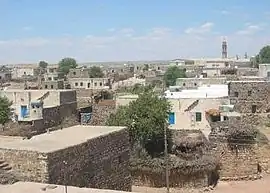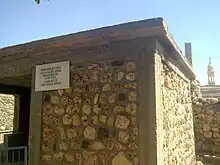Öğündük, İdil
Öğündük (Arabic: مدو; Kurdish: Midin; Syriac: ܡܝܕܘܢ, romanized: Midun)[2][nb 1] is a village in the İdil District of Şırnak Province in Turkey.[5] The village is populated by Assyrians and had a population of 367 in 2021.[1][6]
Öğündük | |
|---|---|
 Village | |
 Öğündük Location in Turkey | |
| Coordinates: 37.338°N 41.746°E | |
| Country | Turkey |
| Province | Şırnak |
| District | İdil |
| Population (2021)[1] | 367 |
| Time zone | TRT (UTC+3) |
History

It has been speculated that Midun (today called Öğündük) was named after the nearby Roman border fort of Mindon along the frontier with the Sasanian Empire in the Melabas Hills of Tur Abdin.[7][nb 2] Some scholars link this to the efforts of the Roman general Belisarius to construct a fort in 528 at Mindouos, which prompted a battle resulting in a defeat for the Romans (Procopius' History of the Wars, 1.13.1-5). Another scholar locates Mindouos about 6 km south-east of Dara (Oğuz, Mardin), far from Öğündük.[8] The village was historically exclusively inhabited by Syriac Orthodox Assyrians.[9]
It was attacked by Bakhti Kurds in 1453 alongside the neighbouring villages of Beth Sbirino, Bēth Isḥaq, and Araban, according to the account of the priest Addai of Basibrina in c. 1500.[10] Bakhti Kurds attacked Midun, as well as the villages of Bēth Isḥaq and Araban, again in 1457 and many of its inhabitants, including the priests Behnam and Malke, were killed.[11] Midun was later looted by the emir Bidayn in 1714 and the Kurdish rebel Yezdanşêr in 1855.[12] After the Hamidian massacres in the 1890s, Armenian refugees from Palu settled a section of the village called Sanhatkar.[13] Midun was visited by the English traveller Mark Sykes in the early 20th century.[14]
Until the First World War, Midun was inhabited by 500 Syriac Orthodox families in thirty-one different clans and had ten churches.[15] Amidst the Sayfo, the village was surrounded and repeatedly attacked by neighbouring Kurdish tribes for a week.[16] Although the Kurdish attacks were repulsed, the villagers opted to take refuge at nearby Beth Sbirino as Midun's location in the plains left it vulnerable.[16] A number of villagers were killed as they travelled to Beth Sbirino; consequently, Kurds of the Domanan tribe seized their homes and settled at Midun.[16] With the help of Chelebi Agha, some villagers were able to return after the war and came under the patronage of the Domanan tribe.[15]
A significant number of the village's Assyrian population emigrated abroad to Germany, Switzerland, and Belgium in the late 20th century.[17] In 1999, Öğündük was inhabited by 50 Assyrian families.[17] In 2007, 257 Assyrians in 50 families inhabited Öğündük.[17]
References
Notes
Citations
- "31 ARALIK 2021 TARİHLİ ADRESE DAYALI NÜFUS KAYIT SİSTEMİ (ADNKS) SONUÇLARI" (XLS). TÜİK (in Turkish). Retrieved 16 December 2022.
- Carlson, Thomas A. (9 December 2016). "Midun — ܡܝܕܘܢ". The Syriac Gazetteer. Retrieved 27 December 2022.
- Barsoum 2003, p. 559; Barsoum 2008, p. 133.
- Jongerden & Verheij (2012), pp. 246, 323.
- "Türkiye Mülki İdare Bölümleri Envanteri". T.C. İçişleri Bakanlığı (in Turkish). Retrieved 19 December 2022.
- Tan (2018), p. 159.
- Palmer (1990), p. 5.
- Lillington-Martin (2012), pp. 4–5.
- Jongerden & Verheij (2012), p. 323.
- Barsoum (2008), p. 70.
- Barsoum (2008), p. 71.
- Barsoum (2008), pp. 131, 133.
- Jongerden & Verheij (2012), p. 249.
- Sykes (1915), pp. 355–356.
- Gaunt 2006, p. 239; Baz 2016, p. 473; Tan 2018, p. 159.
- Gaunt (2006), p. 239.
- Courtois (2013), p. 147.
Bibliography
- Barsoum, Aphrem (2003). The Scattered Pearls: A History of Syriac Literature and Sciences. Translated by Matti Moosa (2nd ed.). Gorgias Press. Retrieved 14 July 2020.
- Barsoum, Aphrem (2008). The History of Tur Abdin. Translated by Matti Moosa. Gorgias Press. Retrieved 1 April 2021.
- Baz, Ibrahim (2016). Şırnak aşiretleri ve kültürü (in Turkish). p. 473. ISBN 9786058849631.
- Courtois, Sébastien de (2013). "Tur Abdin : Réflexions sur l'état présent descommunautés syriaques du Sud-Est de la Turquie,mémoire, exils, retours". Cahier du Gremmamo (in French). 21: 113–150.
- Gaunt, David (2006). Massacres, Resistance, Protectors: Muslim-Christian Relations in Eastern Anatolia during World War I. Gorgias Press. Retrieved 21 May 2023.
- Jongerden, Joost; Verheij, Jelle (2012). Social Relations in Ottoman Diyarbekir, 1870-1915. Brill.
- Lillington-Martin, Chris (2012). "Hard and Soft Power on the Eastern Frontier: a Roman Fortlet between Dara and Nisibis, Mesopotamia, Turkey, Prokopios' Mindouos?" (PDF). The Byzantinist (2): 4–5. Retrieved 27 December 2022.
- Palmer, Andrew (1990). Monk and Mason on the Tigris Frontier: The Early History of Tur Abdin. Cambridge University Press. Retrieved 15 July 2020.
- Sykes, Mark (1915). The Caliphs' Last Heritage: A Short History of the Turkish Empire. Retrieved 27 December 2022.
- Tan, Altan (2018). Turabidin'den Berriye'ye. Aşiretler - Dinler - Diller - Kültürler (in Turkish). p. 159. ISBN 9789944360944.